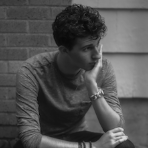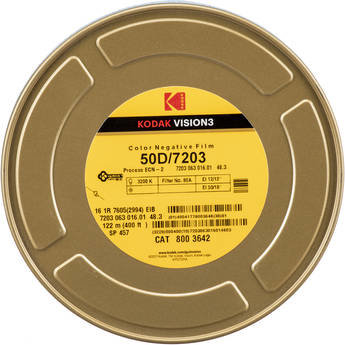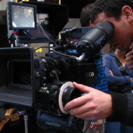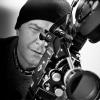Search the Community
Showing results for tags 'Vision 3'.
-
Hi! Is Kodak really going to replace the remjet with an AHU on all Vision3 films? https://kosmofoto.com/2025/06/eastman-kodak-replacing-remjet-layer-from-vision3-cinema-films/
-
More traditional forms of tampering with ones negative in the processing stage include over or under-developing your film, doing a bleach-bypass, or having the film cross processed. Cross processing refers to using a different form of chemical solution and/or pipeline to develop one specific kind of film. I have recently been researching different ways to manipulate the resulting negative in the processing stage, and one idea that had never crossed my mind until now was using the ECN-1 method of development on ECN-2 film. From what I have read, both methods use the exact same chemicals with the same general workflow, only differing in the length of time and temperature used in part A of the process. Wikipedia says that ECN-1... "...involved development at approximately 25 °C for around 7–9 minutes". Firstly, has anyone here ever tried developing ECN-2 film with the ECN-1 processing method? And if so, to what results? Secondly, would anyone be able to gage what this temperature and development time difference would have on the resulting film in terms of resolution, density, dynamic range, contrast, grain, and color? Would ECN-2 film's emulsion even come off with this method, or would that be another potential problem introduced by this workflow?Would the result even be predictable, or is this method so old and unexplored with the new VISION3 stocks that results will end up without a clear pattern of cause and effect? If most people on this page advise me against developing ECN-2 film with the ECN-1 solution then I probably won't take this experiment much further. But I would love to hear your favorite method of cross processing ECN-2 film and what kind of results it ends up having on each VISION3 stock as I am interested in learning more about it. Thank you!
-
Hi All, I'm selling 35mm short end recans. Selling all footage at .25/ft. and have the below stocks available: Kodak 5219 Vision 3 500T Color Negative - 5,817ft Kodak 5260 Vision 2 500T Color Negative - 400ft Kodak 5212 Vision 2 100T Color Negative - 3,687ft Kodak 5201 Vision 2 50D Color Negative - 400ft Kodak 5217 Vision 2 200T Color Negative - 1,395ft Fuji 8583 - 400ft Fuji 8563 - 400ft All recans have over 250 ft of film, some are full 400ft recans. Please PM me or email hschleiff@gmail.com if interested in purchasing. I am based in NYC, but can ship if needed. Best, Harry
- 3 replies
-
- 35mm film
- short ends
- (and 4 more)
-
Hello, I would like to hear some advice, tips.. About 16mm film Vision 3 and it's grain. I recently shot a roll of 100 feet of Vision 3 250D and it turned out great for a Krasnogorsk K3 that I bought for $70 on ebay. I noticed grain specially in the shadows even when I was exposing for middle gray or 18% gray and I had enough light. Nothing wrong with grain. I understand is part of the texture of film and I like it. What I don't like is that after color grading the video (2k, ProRes 444) The grain was moving a lot and it was more like RGB grain than the organic look of film grain. Here is the story: I got to the place where I shot this when the sun was setting. I prepared for shooting and by that time the sun was behind a mountain and I didn't have any specular light. But being Vision 3 250D I was still getting good numbers in the meter. (Sekonic 558). ASA: 250 Frame Speed: 24 Shutter Angle: 150 Apertures: f11 at the beginning, f8 15minutes later, f5.6, etc. I mean there was enough light to expose the film properly. The meter was not suggesting apertures like f1.4 or f1, but I still can notice this grainy areas. Is this normal? Was it because of the time of the day or light conditions? What would you do in that situation? Over expose and then pull in processing? Is it a post production problem? Also do you sharp the image when downscaling from 2k to 1080? I know it's supposed to be almost the same but the image was much larger than the 1080 frame. I can live with that, but I would like to learn more and hopefully get even better results when shooting film. It was my first time with 16mm by the way. Thanks you guys for sharing info and advice. You Tube: http://youtu.be/SKxsLj_p1Jk Dropbox: https://www.dropbox.com/s/cs9ipoxxervacqp/K3%20Wide.mp4?dl=0 You Tube softens the image to a point where grain is almost imperceptible so I'm including a file that you can download if you wanna take a look closer.
- 27 replies
-
Hi All, I'm selling 35mm short end recans. I came into this stock a few years back, a friend worked on the Wolf of Wall Street and was able to get me there recans. I thought I would use them on a project by now but haven't got around to it and they have been kept in safe storage. I'm looking to sell footage at below price points: Kodak 5219 Vision 3 500T Color Negative - 5,817ft (Price = .25/ft) Kodak 5260 Vision 2 500T Color Negative - 400ft (Price = .20/ft) Kodak 5212 Vision 2 100T Color Negative - 3,687ft (Price = .20/ft) Kodak 5201 Vision 2 50D Color Negative - 400ft (Price = .20/ft) Kodak 5217 Vision 2 200T Color Negative - 1,395ft (Price = .20/ft) Fuji 8583 - 400ft (Price = .20/ft) Fuji 8563 - 400ft (Price = .20/ft) All recans have over 250 ft of film, some are full 400ft recans. Please PM me or email hschleiff@gmail.com if interested in purchasing. I am based in NYC, but can ship if needed. Best, Harry
-
Hello cinematography.com friends! I just finished up my latest short film and I wanted to share it with you guys. Shot entirely on vision 3 super 8 stock (50D,500t) This was my first attempt at creating a narrative on actual film. The camera used was a Sankyo 40s xl and the process/2k scan was performed by Pro8mm in Burbank. Thanks! Happy New Years. - Hunter <iframe src="https://player.vimeo.com/video/197584631"width="640" height="486" frameborder="0" webkitallowfullscreen mozallowfullscreen allowfullscreen></iframe>
-
Hey guys, I'm looking for a bit of advice, stock-wise. We're shooting the first ten minutes of our feature film this month and unfortunately my DP is as unfamiliar with film as I am. For outdoor scenes, I'm looking into the KODAK Vision 3 250D. One shot in particular, we transition from the roof of our building to the inside of our apartment. I dug up an article on Fuji's old 250. The tester claimed it would work very well under such a transition. I'm assuming that Kodak can achieve the same result? http://www.fujifilm.com/products/motion_picture/lineup/eterna_vivid250d/demo/ what would you recommend, lighting-wise, once we hit the interior. In the same one-shot, we travel quite aways around the apartment. Sometimes, windows are plentiful, sometimes not so much. for everything else, I thought we could use kodak 500t. but I don't know how that would match up either. does anyone know if I'm looking in the right places? if not, can you point me in the right direction. (i also considered throwing an 85 on something like a 200t to achieve the same effect, but I'm new at this, and I don't really know what I'm talking about) thank you for your help, for more information on our movie check us out at po.st/sowhat
-
Here is another fashion shot with 50d Vision 3. The telecine was done by Ochoypico, the camera used my Beaulieu 4008 ZM2.
-
Hey Everyone, Here's a long form commercial I shot on Super 16mm on the Krasnogorsk K3. I'm really happy with the way it turned it out. I showed it to non industry people and someone asked me how I got it to look the way it does and my I told them, "It looks like that because it was shot on film". I feel like it wouldn't be the way it is if I shot it on any other format. I would definitely appreciate any comments or criticisms! Thanks, Mike https://vimeo.com/74120596
- 12 replies
-
- 2
-

-
- Super 16mm
- Kodak
-
(and 4 more)
Tagged with:
-
Finally finished writing my article after several months of research and tests. I'm putting it out there, so if anybody in the future is interested they can learn everything they need from this article to get them going. Article Includes: - The film advantages and disadvantages. - Development times. - Procedures. - Workarounds. And much more information. Thanks https://republicphoto.squarespace.com/s/ECN-DEV4.pdf







